Snapshots of Vanuatu

|
Snapshots of Vanuatu
We haven’t always had strong enough
internet to update the blog with pictures – but back here in Port Vila we’ve
got no excuse! Here’s some random shots
that didn’t “fit” with any of our previous tales.
You will have gathered that Vanuatu is
extremely diverse – the islands have different landscapes, soil, water, crops,
languages, crafts and customs. The
people look physically very different from each other and if it wasn’t for the
common language of Bislama they wouldn’t be able to communicate. If you just speak in English – with a lisp –
like you’ve had a few drinks – it kind comes out close to Bislama – here’s the
basic emotions ……
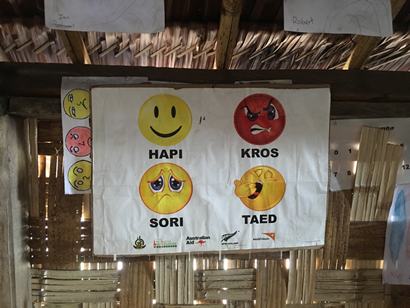
And I’m sure you all get the drift of
the warning on the cigarette packet (Just read it how it looks)
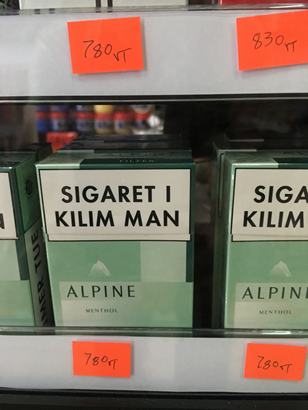
The 80 odd islands are well serviced by
a fleet of ferries that deliver absolutely everything throughout the island
chain. There are few “harbours” to speak
of so the vessels are all shallow draft that drive right up practically onto
the beach to pick up and deliver their goods.
The arrival of a ferry is always a big event – everyone turns up on the
beach and it’s always good entertainment to watch (and hear) all the goings on.
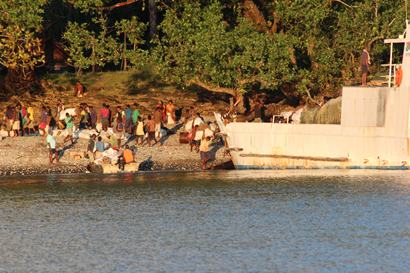
On Ambrym the biggest ferry day of the
year was the day around 140 cows came from Santo. I don’t’ think a single person from a number
of villages missed that spectacle. A
special race was built out into the bay to guide the stock from the ferry…
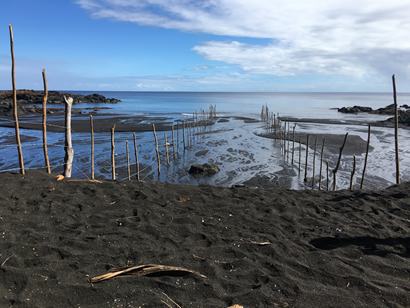
Amongst massive cheering and laughter
the “new residents” made their way ashore.
 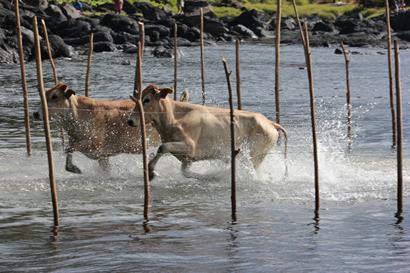
We hadn’t noticed many cows on the
island and talking to the locals they said that most of their cows had been
“lost”. We thought perhaps something had
happened during cyclone Pam - but no –“lost’ – translates to “eaten” and they
just needed some moreJ We did a roaring trade with old lengths of
rope – everyone was asking for “cow rope” to lead the new member of the family
home before inviting them to dinner at some point in the future. It was an extremely well executed affair with
all cows pre-ordered and paid for in advance.
The younger folk however looked very concerned ….
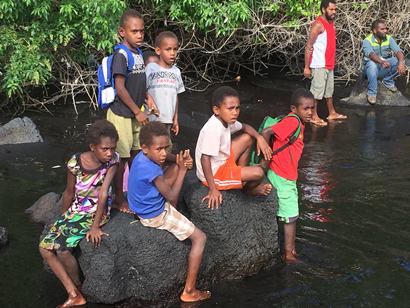
The villages don’t have much
infrastructure but they have a system worked out for just about
everything. Generally there is no
electricity in houses, but nearly everyone has a cell phone with small phone
solar panels. These don’t always work
that well and once in Maewo we had 6 cell phones on charge in our boat – once
the word got out – the canoes came ……
There’s usually a bigger solar panel somewhere in the village such as in
Tanna where everyone bought in the house lantern to charge in the community hall
during the day and collected them again before nightfall.
We always loved the villages with bakeries
as baking bread onboard is a hot, sweaty and tiresome process in the
tropics. On Epi this is the local baker
Joseph who lights fires under 40 gallon drums that are his ovens. He controls
the heat with the little door and produces fine loavesJ
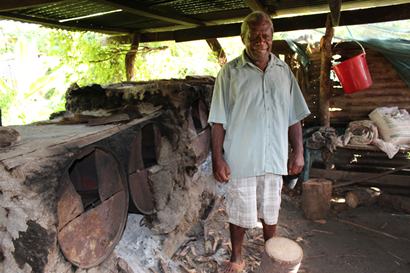 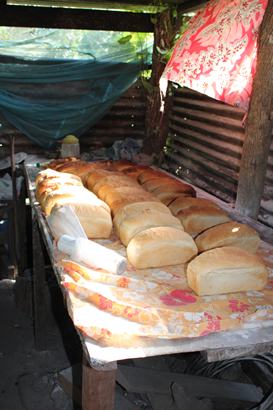
Children everywhere are always good for
a laugh. One of our favourite pass-times
is “bubble bombing”. This is a highly
technical affair of judging approaching canoe speed compared with wind
direction and speed, and then letting off some bubbles off the back of the boat
(hopefully while no-one’s watching) and letting them drift over to the
unsuspecting little ones J The bubbles go for miles and then there’s
squeals of delight as the “targets” race around trying to catch them – great
entertainment for everyone J (including the big kids).
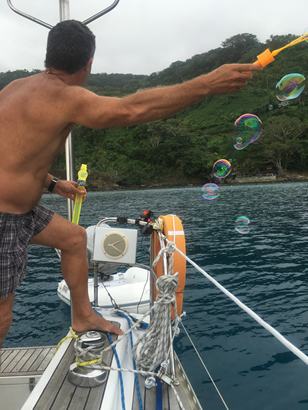 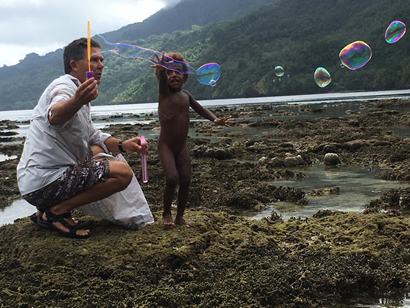
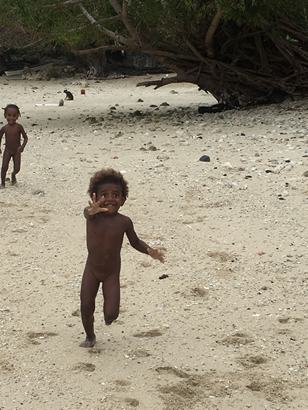 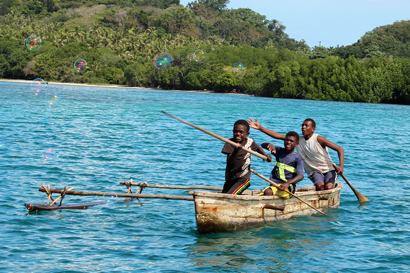 Children here will play with absolutely
anything. A fridge arrived for the
health centre and these boys played every day in their own polystyrene “boats”
until they broke.
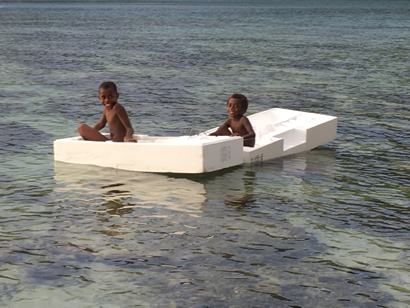
Villagers are often proud to show you
their local school and kids always ask us to take their photos and then they
climb all over you to get a look at the picture – here’s a typical line up.

We have also been lucky enough to be
invited into people’s homes which seems less common here for cruisers than it
is in Fiji. Kava is strictly men’s
business – very powerful – two shells and its advisable to stand up – just to
make sure you still can – before consuming any more. Fresh Kava root is grated using a sharpened
“log” of coral, then squeezed a number of times through fine dried bark before
producing 100% Kava “juice”. None of
this mixing with a bucket of water stuff!
 
Women’s business is cooking, and the
Ni-van national dish is “lap lap”. Made
from grated yam, mixed with coconut milk, its usually baked underground, or in
this case in tubes of bamboo in the cooking fire. This is Mary in her “kitchen” turning our
dinner over in the coals to perfect its baking.
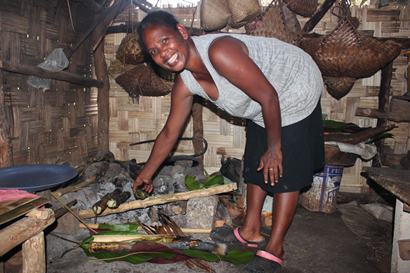
I cannot possibly convey the importance
of yams to a Ni-van. I guess back in the
day – no yams = no food – and it is still the main food source. We had no idea how big they can grow. We met this guy between villages on
Ambrym. We thought from a distance that
he was carrying the outrigger of a canoe but as we got closer it became
apparent that it was in fact a yam – larger than he was tied to a stick frame
carried between 2 men. He was shipping
it to Port Vila to sell it as a yam this big is worth big bucks!!
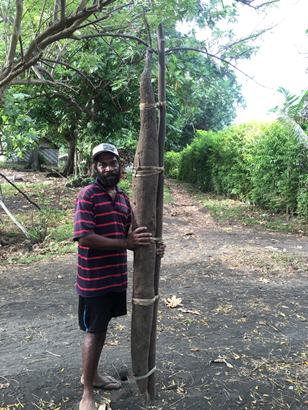
Speaking of canoes, in the Maskelyne
islands, people still get round in traditional sailing canoes – when they can
find a sail. This canoe was carrying the
entire family on a “drive by” of Navara.
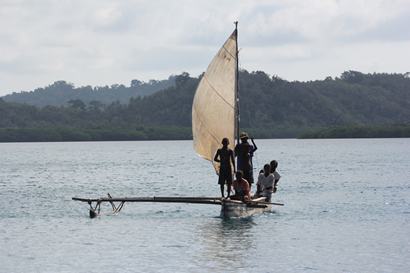
Canoes are still made 100% the old
fashioned way – all sticks and woven bindings – no nails or glue here. (that’s the kiwi fibreglass canoe in the
background J
)

“Floating hotels” carrying 10 times the number
of people who live in the average village – AKA the P&O Cruise Ships are
seen regularly here. Being close to
Australia, New Caledonia and Vanuatu are very popular cruise destinations. Waking up to this outside your window is a
bit disconcerting – it appears we must have been parked on their “spot”.

We call the occupants “marshmallows” –
round, soft squishy people who are either white or pink (sunburnt) - the cruise
ships disgorge large quantities of these overweight beer swilling Aussies
ashore. The villagers go to great
lengths to try and separate a bit of cash from the marshmallows which is quite
entertaining. A favourite is designing
some “tour” or activity to offer.
There’s a central notice board when passengers first come ashore where
all the possibilities for the day are displayed. This is a classic …
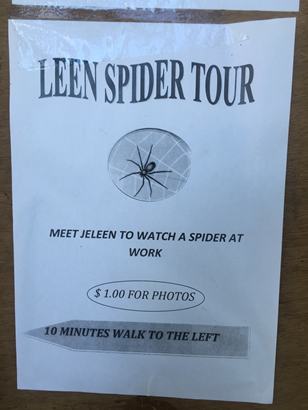
Well – that’s about it folks – we hope
to head across to New Caledonia in a few days when the wind turns a bit more to
the east (and hopefully north east) giving us a two day break in the trades to
head south to cooler climes. We’re
looking forward to all those French bread and pastries but will miss the water
temperature of 27 or 28 degrees.
For now – here’s the early morning scene
that farewelled us off the beautiful island of Paama.

Lookem you!! |